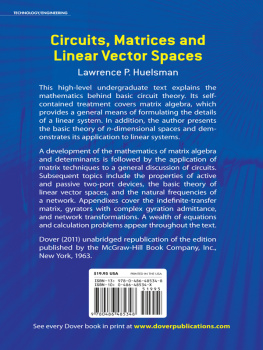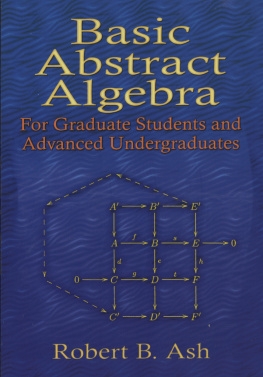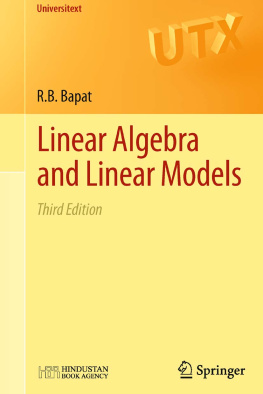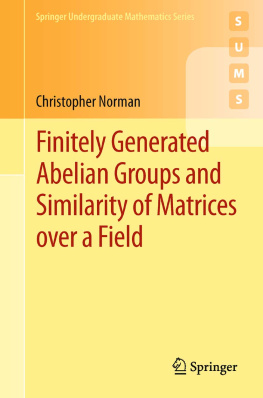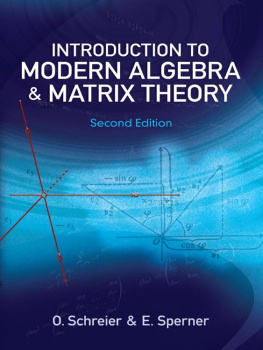Circuits, Matrices and
Linear Vector Spaces
Circuits, Matrices and
Linear Vector Spaces
Bibliographical Note
This Dover edition, first published in 2011, is an unabridged republication of the work originally published in 1963 by the McGraw-Hill Book Company, Inc., New York.
Library of Congress Cataloging-in-Publication Data
Huelsman, Lawrence P.
Circuits, matrices, and linear vector spaces / Lawrence P. Huelsman.
Dover ed.
p. cm.
Originally published: New York: McGraw-Hill Book 1963.
Includes bibliographical references and index.
ISBN-13: 978-0-486-48534-8 (pbk.)
ISBN-10: 0-486-48534-X (pbk.)
1. Electronic circuits. 2. Matrices. 3. Vector spaces. I. Title.
QA401.H8 2012
621.3815dc23
2011014833
Manufactured in the United States by Courier Corporation
48534X01
www.doverpublications.com
to my father and mother
Courses in circuit theory may have many goals. The introductory courses usually develop basic concepts which are applied throughout all subsequent studies of electrical engineering. The later undergraduate courses are usually set up to provide the student with an insight into specific circuits and devices. A common factor in all this education, perhaps not always realized by the student, is that the training he receives in circuits provides him with a foundation of knowledge which is applicable to many disciplines. This is perhaps one of the most worthwhile results that can occur from a study of any subject.
It is the purpose of this book to add to the undergraduate knowledge of circuits possessed by a senior or first-year graduate student in such a way as to broaden his foundation of knowledge, not only with respect to circuits, but with respect to other areas of study as well. Among its specific purposes are the following:
First, to encourage the student to think in terms which are as general as possible. Thus, we introduce the subject of matrix algebra, which provides a general means of formulation for the details of a linear system.
Second, to select a broad and versatile framework on which to base his observations of electrical circuits and system phenomena. Thus, we present the basic theory of n -dimensional spaces and show how this can be applied to linear systems.
Third, to teach the student to differentiate between models useful because they approximate physical devices and models useful because they are theoretically powerful or analytically simple. Thus, we present such modern circuit elements as the ideal transformer, the negative-immittance converter, and the gyrator and show how these may be used in the synthesis and analysis of electric circuits.
Finally, to aid the student in preparing for his own explorations into the literature of current journals and publications.
There are two dominant premises which have been followed in the organization of the material. First, it was desired to have the book as completely self-contained as possible, in that all the required concepts of matrix algebra and linear vector spaces would be developed as an integral part of the book. In the presentation of this mathematical material, a middle course has been chosen, avoiding the extremes of mathematical rigor in favor of emphasizing the concepts which are important from the viewpoint of application. Second, it was felt that comprehension of the mathematical material would be gained only as a result of thorough application. Thus, each chapter devoted to a mathematical presentation is immediately followed by a chapter in which that material is used as fully as possible.
There are several main divisions of the material.. Specifically, they cover the indefinite-transfer matrix, gyrators with complex gyration admittance, and network transformations.
Depending on the background of the students and the approach favored by the instructor, the book may be used in several ways. For example, a one-semester course for senior students of all engineering disciplines might include the material of .
I would like to express my thanks and appreciation to the following: Prof. D. O. Pederson of the University of California, whose enthusiasm as a teacher first awakened my interest in circuits; Prof. M. E. Van Valkenberg of the University of Illinois, for his encouragement during the months of writing; Prof. A. Gill of the University of California, for his helpful criticism of the manuscript; and my students, whose searching questions have led to much revision of my original thoughts.
L. P. Huelsman
Contents
There are several classifications under which circuits, as they are studied today, may be grouped. Some of these classifications are determined by the properties of the circuit elements, and some of them are the result of the manner in which these elements are interconnected. In this chapter we shall present some of the basic ideas concerning the classification of circuits and circuit elements according to their properties. This material will serve to introduce some of the terms that will frequently appear in later sections of the book. It will also serve to review some of the basic ideas of circuit theory. Additional information on the topics of this chapter can be found in the references listed in the final section of the chapter.
In a consideration of the elements of which a circuit is composed, a first distinction must be made as to the number of terminals that such elements possess. Since a one-terminal element is without physical significance, let us begin by considering elements with two terminals. These elements can, in general, be grouped according to the following divisions: linear or non-linear, lumped or distributed, passive or active. Let us consider each of these classifications and discuss its principal characteristics.
A linear element can be defined in terms of the requirements of superposition and homogeneity. Superposition requires that, if two inputs are simultaneously applied to an element, the result be the sum of the results obtained from separate application of those same inputs. Thus, if the result of applying a d-c voltage of 1 volt to a given element is a d-c current of 1 amp through the element, and the result of applying an a-c voltage, sin 2 t , to the element is a current 2 sin 2 t , superposition requires that, if an input voltage 1 + sin 2 t is applied to the element, a current 1 + 2 sin 2 t results. The principle of homogeneity may be explained as follows: If a given input produces a certain result, then multiplying the magnitude of the input by a constant will multiply the value of the result by the same constant. A linear circuit element is one which satisfies the requirements of superposition and homogeneity. No physical device is actually linear; however, it is convenient to approximate such devices by models which are idealized in the sense that they are defined as being linear.
A lumped element is one whose properties can be considered as concentrated in space. From another viewpoint, it is one in which the time of propagation of electrical phenomena through the element is zero. A transmission line is an example of a nonlumped element, i.e., a distributed device. Actually, all physical devices can be considered as being distributed, since they have nonzero dimensions. It is convenient, however, to approximate physical devices by models which are considered as lumped. Thus, we shall treat our circuit elements as lumped and linear.
Three of the basic circuit elements which we shall consider are the positive-valued resistor , the positive-valued inductor , and the positive-valued capacitor . These are the elements that relate voltage and current, voltage and the derivative of current, and voltage and the integral of current, respectively. They will be treated as lumped linear elements. They are considered as passive elements in that they approximate physical devices which do not require a source of energy to achieve their specified properties. We shall see that elements which can be described as negative-valued resistors, inductors, and capacitors can also be considered in our circuit studies. The physical devices which these elements approximate, in general, require external power sources to sustain their operation. Thus, these elements will be referred to as active elements.

